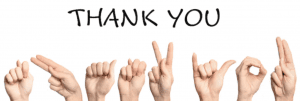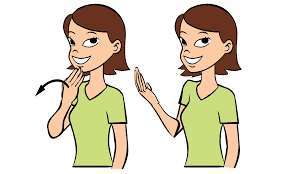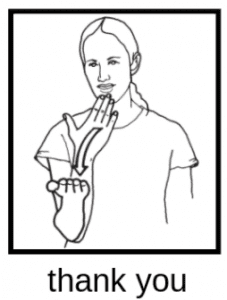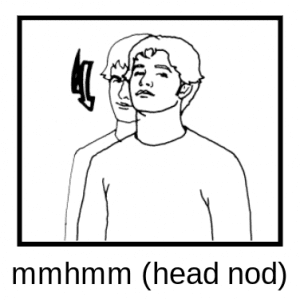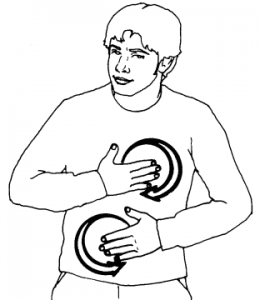Thank you, or the simpler form- thanks, is a polite expression of one’s gratitude and is used often in everyday interactions. While manners and etiquette differ between cultures, a sincere thank you is an easy way to show gratitude among most people. Since showing respect and good manners is necessary when learning new languages, including American Sign Language (ASL), learning to sign thank you is important. So let’s jump right in and discuss the hand sign for thank you, you’re welcome, and some other helpful expressions in ASL.
How to Say Thank You in Sign Language
First, a little linguistics to warm us up. Cognates are words in two languages that can share a similar meaning, spelling, pronunciation, linguistic derivation, or root. While all sign languages around the world are different from each other, French Sign Language (FSL) heavily influenced the indigenous sign language to the US, resulting in ASL.
FSL was brought to the U.S. by Frenchman Laurent Clerc, one of Gallaudet University’s founders. So, it should come as no surprise that the sign for thank you is the same in both FSL and ASL. In fact, according to Dr. Susan Rutherford (1993), approximately 60 percent of ASL vocabulary can be traced to FSL cognates. But don’t get caught up with FSL, at least not yet anyway. You’re here because you’re interested in ASL.
Let’s start with English, since you’re currently reading it. In English, thank you requires two words to make sense, the verb “to thank” and the object “you.” However, only one sign is used to say thank you in ASL. In this sign, the object “you” is already included. This is because the grammar and syntax of English and ASL are different.
So how do you say thank you in asl?
Thank you is signed one-handed (using your dominant hand), with a flat hand, palm facing towards the face, fingertips starting at the chin, and the hand arcing out from the chin towards the person you are thanking, as shown in the image here:
Also, don’t forget to smile when signing thanks sign language so that the other person knows you’re sincere. Facial expressions play an important role in ASL grammar and should be used in conjunction with appropriate signs.
Thank You VERY Much
To express a heightened level of gratitude, you can use the sign for “thank you so much” in sign language. There are a few ways to emphasize that you are very grateful when signing thank you. One way is to use both hands to sign thank you, which is also useful when you are thanking several people or a large group all at once. When using two hands, you are saying many thanks or thank you so much, which are both appropriate depending on the context and intonation you use. Another way to show emphasis is to repeat the sign thank you several times. Now that you know how to sign thank you and thank you very much, it’s time for a bit of caution.
PSA About Signing Thank you
Thank you is signed one-handed from the front of the chin. Be careful not to begin that sign under the chin before arcing outward or you change it to f*** you, which is considered offensive to most people.
Further, starting at your cheek, next to your chin, and moving outward is the sign for prostitute, or similar terms.
Finally, starting from your lips, rather than your chin before the outward arc, is blowing a kiss. A misplaced sign starting point can be the difference between a sign of gratitude and one of insult. That makes it essential to use the correct palm orientation, handshape, location, non-manual signals/ expressions, and other language features you’ll learn about later, when signing ASL.
Responding to “Thank you”
Responding to thank you in sign language is more similar to de nada in Spanish than to you’re welcome in English. There are several options for responding to thank you in ASL. As with other languages, you can simply nod your head and smile. But keep in mind that this option is casual and more often used with friends and family.
Other signs to respond to thank you include no problem, it was nothing, and all-good. A less common option is to sign thank you back to the person who thanked you. See a few of the optional responses here:
Other Expressions
While thank you is the most common expression of gratitude, the word appreciate holds similar value in English. In ASL, the sign for appreciate is the same as the sign used for enjoy; the subtle difference is made within context and intonation. Though the sign appreciate is not used as often as thank you, you may want to use it or see others who do.
Appreciate & Enjoy
Lastly, when discussing manners, please and thank you go hand in hand, no pun intended. To sign please, take your dominant, flat hand with thumb extended, palm facing in, and rub it in a clockwise circle on your chest as shown in the picture below.
Please
Hopefully, you’ve been following everything discussed so far, but it wouldn’t be right if a monkey wrench wasn’t thrown in. It’s worth noting that the sign for please is also the same sign as enjoy. That’s right, some signers use one hand, instead of two, to sign enjoy, so it looks just like please.
And we just learned that enjoy and appreciate are the same sign, which means that the sign for please, appreciate, and enjoy can all look the exact same. It’s all about context and facial expressions. Don’t worry, with practice and exposure to other signers, you’ll begin to learn the subtle differences. For now, focus on learning the basics.
Thank YOU for Learning…
Now that you know how to sign thank you in ASL, you are ready to start showing your gratitude. And, now some gratitude from me to you: a heartfelt thank you, شكرا, 谢谢, merci, danke, grazie, ありがとう, 고마워, obrigada, cпасибо, gracias, 唔該, dank je, kiitos, ευχαριστώ, धन्यवाद, mahalo, dziękuję Ci, mulţumesc, and tack for your interest in ASL.
Magen Hom

